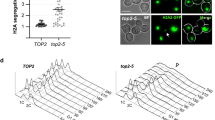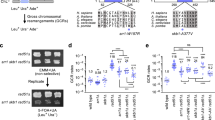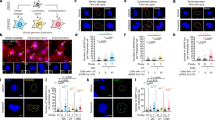Abstract
Cancer progression is often associated with the accumulation of gross chromosomal rearrangements (GCRs), such as translocations, deletion of a chromosome arm, interstitial deletions or inversions1,2,3. In many instances, GCRs inactivate tumour-suppressor genes or generate novel fusion proteins that initiate carcinogenesis3,4. The mechanism underlying GCR formation appears to involve interactions between DNA sequences of little or no homology5,6,7,8. We previously demonstrated that mutations in the gene encoding the largest subunit of the Saccharomyces cerevisiae single-stranded DNA binding protein (RFA1) increase microhomology-mediated GCR formation8. To further our understanding of GCR formation, we have developed a novel mutator assay in S. cerevisiae that allows specific detection of such events. In this assay, the rate of GCR formation was increased 600–5,000-fold by mutations in RFA1, RAD27, MRE11, XRS2 and RAD50, but was minimally affected by mutations in RAD51, RAD54, RAD57, YKU70, YKU80, LIG4 and POL30. Genetic analysis of these mutants suggested that at least three distinct pathways can suppress GCRs: two that suppress microhomology-mediated GCRs (RFA1 and RAD27) and one that suppresses non-homology–mediated GCRs (RAD50/MRE11/XRS2).
This is a preview of subscription content, access via your institution
Access options
Subscribe to this journal
Receive 12 print issues and online access
$209.00 per year
only $17.42 per issue
Buy this article
- Purchase on Springer Link
- Instant access to full article PDF
Prices may be subject to local taxes which are calculated during checkout


Similar content being viewed by others
References
Shikano, T., Arioka, H., Kobayashi, R., Naito, H. & Ishikawa, Y. Jumping translocations of 1q in Burkitt lymphoma and acute nonlymphocytic leukemia. Cancer Genet. Cytogenet. 71, 22–26 ( 1993).
Mitelman, F. Catalog of Chromosome Aberration in Cancer (Wiley Liss, New York, 1991).
Gauwerky, C.E. & Croce, C.M. Chromosomal translocations in leukaemia. Semin. Cancer Biol. 4, 333– 340 (1993).
Barr, F.G. Translocations, cancer and the puzzle of specificity. Nature Genet. 19, 121–124 ( 1998).
Woods-Samuels, P., Kazazian, H.H. & Antonarakis, S.E. Nonhomologous recombination in the human genome: deletions in the human factor VIII gene. Genomics 10, 94–101 (1991).
Luzi, P., Rafi, M.A. & Wenger, D.A. Characterization of the large deletion in the GALC gene found in patients with Krabbe disease. Hum. Mol. Genet. 4, 2335–2338 (1995).
Gilman, J.G. The 12.6 kilobase DNA deletion in Dutch β zero-thalassaemia. Br. J. Haematol. 67, 369–372 (1987).
Chen, C., Umezu, K. & Kolodner, R.D. Chromosomal rearrangements occur in S. cerevisiae rfa1 mutator mutants due to mutagenic lesions processed by double-strand-break repair. Mol. Cell 2, 9– 22 (1998).
Wold, M.S. Replication protein A: a heterotrimeric, single-stranded DNA-binding protein required for eukaryotic DNA metabolism. Annu. Rev. Biochem. 66, 61–92 (1997).
Umezu, K., Sugawara, N., Chen, C., Haber, J.E. & Kolodner, R.D. Genetic analysis of yeast RPA1 reveals its multiple functions in DNA metabolism. Genetics 148, 989–1005 (1998).
Merrill, B.J. & Holm, C. The RAD52 recombinational repair pathway is essential in pol30 (PCNA) mutants that accumulate small single-stranded DNA fragments during DNA synthesis. Genetics 148, 611–624 (1998).
Lieber, M.R. The FEN-1 family of structure-specific nucleases in eukaryotic DNA replication, recombination, and repair. Bioessays 19, 233–240 (1997).
Tishkoff, D.X., Filosi, N., Gaida, G.M. & Kolodner, R.D. A novel mutation avoidance mechanism dependent on S. cerevisiae RAD27 is distinct from DNA mismatch repair. Cell 88, 253– 263 (1997).
Haber, J. The many interfaces of Mre11. Cell 95, 583 –586 (1998).
Tsukamoto, Y., Kato, J. & Ikeda, H. Budding yeast Rad50, Mre11, Xrs2, and Hdf1, but not Rad 52, are involved in the formation of deletions on a dicentric plasmid. Mol. Gen. Genet. 255, 543–547 ( 1997).
Tsukamoto, Y., Kato, J. & Ikeda, H. Effects of mutations of RAD50, RAD51, RAD52, and related genes on illegitimate recombination in Saccharomyces cerevisiae. Genetics 142, 383–391 ( 1996).
Moore, J.K. & Haber, J.E. Cell cycle and genetic requirements of two pathways of nonhomologous end-joining repair of double-strand breaks in Saccharomyces cerevisiae. Mol. Cell. Biol. 16, 2164–2173 (1996).
Malkova, A., Ivanov, E.L. & Haber, J.E. Double-strand break repair in the absence of RAD51 in yeast: a possible role for break-induced DNA replication. Proc. Natl Acad. Sci. USA 93, 7131– 7136 (1996).
Bosco, G. & Haber, J.E. Chromosome break-induced DNA replication leads to nonreciprocal translocations and telomere capture. Genetics 150, 1037–1047 ( 1998).
Ninio, J. Transient mutators: a semiquantitative analysis of the influence of translation and transcription errors on mutation rates. Genetics 129, 957–962 (1991).
Carney, J.P. et al. The hMre11/hRad50 protein complex and Nijmegen breakage syndrome: linkage of double-strand break repair to the cellular DNA damage response. Cell 93, 477–486 (1998).
Matsuura, S. et al. Positional cloning of the gene for Nijmegen breakage syndrome. Nature Genet. 19, 179– 181 (1998).
Chrzanowska, K.H. et al. Eleven Polish patients with microcephaly, immunodeficiency, and chromosomal instability: the Nijmegen breakage syndrome. Am. J. Med. Genet. 57, 462–471 (1995).
Lea, D.E. & Coulson, C.A. The distribution of the numbers of mutants in bacterial populations. J. Genet. 49, 264–285 (1948).
Wach, A., Brachat, A., Pohlmann, R. & Philippsen, P. New heterologous modules for classical or PCR-based gene disruptions in Saccharomyces cerevisiae. Yeast 10, 1793–1808 (1994).
Maniar, H.S., Wilson, R. & Brill, S.J. Roles of replication protein-A subunits 2 and 3 in DNA replication fork movement in Saccharomyces cerevisiae. Genetics 145, 891–902 ( 1997).
Amin, N.S. & Holm, C.H. In vivo analysis reveals that the interdomain region of the yeast proliferating cell nuclear antigen is important for DNA replication and DNA repair. Genetics 144, 479–493 (1996).
Schulz, V.P. & Zakian, V.A. The saccharomyces PIF1 DNA helicase inhibits telomere elongation and de novo telomere formation. Cell 76, 145–155 ( 1994).
Kramer, K.M. & Haber, J.E. New telomeres in yeast are initiated with a highly selected subset of TG1-3 repeats. Genes Dev. 7, 2345–2356 (1993).
Acknowledgements
We thank T. Nakagawa, K.J. Myung and A. Datta for discussions and comments, and J. Weger and J. Green for performing DNA sequencing. This work was supported by NIH grants GM26017 and GM50006 to R.D.K.
Author information
Authors and Affiliations
Corresponding author
Rights and permissions
About this article
Cite this article
Chen, C., Kolodner, R. Gross chromosomal rearrangements in Saccharomyces cerevisiae replication and recombination defective mutants. Nat Genet 23, 81–85 (1999). https://doi.org/10.1038/12687
Received:
Accepted:
Issue Date:
DOI: https://doi.org/10.1038/12687
This article is cited by
-
Double-strand breaks induce inverted duplication chromosome rearrangements by a DNA polymerase δ-dependent mechanism
Nature Communications (2023)
-
Signification and Application of Mutator and Antimutator Phenotype-Induced Genetic Variations in Evolutionary Adaptation and Cancer Therapeutics
Journal of Microbiology (2023)
-
ISG15 conjugation to proteins on nascent DNA mitigates DNA replication stress
Nature Communications (2022)
-
Rad27 and Exo1 function in different excision pathways for mismatch repair in Saccharomyces cerevisiae
Nature Communications (2021)
-
The Swr1 chromatin-remodeling complex prevents genome instability induced by replication fork progression defects
Nature Communications (2018)



